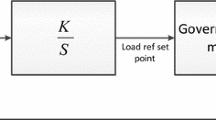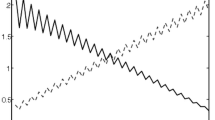Abstract
In this paper, a novel ant lion optimization algorithm is proposed for the recent availability-based tariff (ABT) pricing scheme for the automatic generation control of a three-area interconnected power system (IPS). The innovative ant lion optimizer (ALO) process is performed in conjunction with ABT. The real frequency and load variation are realistic to the input of ALO and minimize the objective function area control error, generation costs and marginal cost of the system. Based on the output of the ALO, the ABT is resolute and assumed as the input of the proposed controller. The dynamic performance of the three-area IPS values including hydrothermal, wind turbine and photovoltaic power systems are evaluated on the basis of limits such as frequency deviation, generation power and tie-line power. Based on these limits, the frequency deviation is controlled and the parameters of the multi-resolution PID (MRPID) controller are regulated. The proposed MRPID controller is modified with the proposed ABT-based ALO to increase the optimal resolution. A three-area IPS is modeled under numerous loads to improve the efficiency of the proposed algorithm. The performance of the this method is demonstrated and compared with existing methods including particle swarm optimization and gravitational search algorithm.










Similar content being viewed by others
References
Abd-Elazim SM, Ali ES (2016) Load frequency controller design via BAT algorithm for nonlinear interconnected power system. Int J Electr Power Energy Syst 77:166–177
Aditya SK (2003) Design of load frequency controllers using genetic algorithm for two area interconnected hydro power system. Electric Power Compon Syst 31(1):81–94
Al-Hamouz ZM, Abdel-Magid YL (1993) Variable structure load frequency controllers for multiarea power systems. Int J Electr Power Energy Syst 15(5):293–300
Al-Hamouz ZM, Al-Duwaish HN (2000) A new load frequency variable structure controller using genetic algorithms. Electr Power Syst Res 55(1):1–6
Ali ES, Abd-Elazim SM (2011) Bacteria foraging optimization algorithm-based load frequency controller for interconnected power system. Int J Electr Power Energy Syst 33(3):633–638
Ali ES, Abd-Elazim SM (2013) BFOA based design of PID controller for two area load frequency control with nonlinearities. Int J Electr Power Energy Syst 51:224–231
Ali ES, Abd Elazim SM, Abdelaziz AY (2016) Ant lion optimization algorithm for renewable distributed generations. Int J Energy 116:445–458
Çam E (2007) Application of fuzzy logic for load frequency control of hydroelectrical power plants. Energy Convers Manag 48(4):1281–1288
Chandrakala KRMV, Balamurugan S, Sankaranarayanan K (2013) Variable structure fuzzy gain scheduling based load frequency controller for multi source multi area hydro thermal system. Int J Electr Power Energy Syst 53:375–381
Chidambaram IA, Velusami S (2005) Design of decentralized biased controllers for load-frequency control of interconnected power systems. Electric Power Compon Syst 33(12):1313–1331
Diaf S, Diaf D, Belhamel M, Haddadi M, Louche A (2007) A methodology for optimal sizing of autonomous hybrid PV/wind system. Int J Energy Policy 35(11):5708–5718
Dihrab SS, Sopian K (2010) Electricity generation of hybrid PV/wind systems in Iraq. Int J Renew Energy 35(6):1303–1307
Diniz AL, Maceira MEP (2008) A four-dimensional model of hydro generation for the short-term hydrothermal dispatch problem considering head and spillage effects. IEEE Trans Power Syst 23(3):1298–1308
Elsisi M, Soliman M, Aboelela MAS, Mansour W (2016) Bat inspired algorithm based optimal design of model predictive load frequency control. Int J Electr Power Energy Syst 83:426–433
Febin Daya JL, Subbiah V, Sanjeevikumar P (2013) Robust speed control of an induction motor drive using wavelet-fuzzy based self-tuning multiresolution controller. Int J Comput Intell Syst 6(4):724–738
Gozde H, Cengiz Taplamacioglu M, Kocaarslan I (2012) Comparative performance analysis of artificial bee colony algorithm in automatic generation control for interconnected reheat thermal power system. Int J Electr Power Energy Syst 42(1):167–178
Liu X, Kong X, Lee KY (2016) Distributed model predictive control for load frequency control with dynamic fuzzy valve position modelling for hydro–thermal power system. IET Control Theory Appl 10(14):1653–1664
Mohanty B, Panda S, Hota PK (2014) Controller parameters tuning of differential evolution algorithm and its application to load frequency control of multi-source power system. Int J Electr Power Energy Syst 54:77–85
Nanda J, Mangla A, Suri S (2006) Some new findings on automatic generation control of an interconnected hydrothermal system with conventional controllers. IEEE Trans Energy Convers 21(1):187–194
Nayeripour M, Hoseintabar M, Niknam T (2011) Frequency deviation control by coordination control of FC and double-layer capacitor in an autonomous hybrid renewable energy power generation system. Int J Renew Energy 36(6):1741–1746
Nema P, Nema RK, Rangnekar S (2009) A current and future state of art development of hybrid energy system using wind and PV-solar: a review. Int J Renew Sustain Energy Rev 13(8):2096–2103
Pandey SK, Mohanty SR, Kishor N (2013) A literature survey on load–frequency control for conventional and distribution generation power systems. Renew Sustain Energy Rev 25:318–334
Parmar KS, Majhi S, Kothari DP (2012) Load frequency control of a realistic power system with multi-source power generation. Int J Electr Power Energy Syst 42(1):426–433
Prakash S, Sinha SK (2014) Simulation based neuro-fuzzy hybrid intelligent PI control approach in four-area load frequency control of interconnected power system. Appl Soft Comput 23:152–164
Rahman A, Saikia LC, Sinha N (2017) Automatic generation control of an interconnected two-area hybrid thermal system considering dish-stirling solar thermal and wind turbine system. Renewable Energy 105:41–54
Sahu BK, Pati TK, Nayak JR, Panda S, Kar SK (2016) A novel hybrid LUS–TLBO optimized fuzzy-PID controller for load frequency control of multi-source power system. Int J Electr Power Energy Syst 74:58–69
Shayeghi H, Shayanfar HA (2006) Application of ANN technique based on μ-synthesis to load frequency control of interconnected power system. Int J Electr Power Energy Syst 28(7):503–511
Shayeghi HASH, Shayanfar HA, Jalili A (2009) Load frequency control strategies: a state-of-the-art survey for the researcher. Energy Convers Manag 50(2):344–353
Swift G, Molinski TS, Waldemar L (2001) A fundamental approach to transformer thermal modeling I. Theory and equivalent circuit. IEEE Trans Power Deliv 16(2):171–175
Tang Y, Bai Y, Huang C, Bin D (2015) Linear active disturbance rejection-based load frequency control concerning high penetration of wind energy. Energy Convers Manag 95:259–271
Verma YP, Kumar A (2013) Economic-emission load dispatch in renewable integrated system under availability based tariff (ABT) environment. Int J Sustain Energy Technol Assess 4:78–88
Vrdoljak K, Peric N, Petrovic I (2010) Sliding mode based load-frequency control in power systems. Electr Power Syst Res 80(5):514–527
Yang TC, Ding ZT, Yu H (2002) Decentralised power system load frequency control beyond the limit of diagonal dominance. Int J Electr Power Energy Syst 24(3):173–184
Zeynelgil HL, Demiroren A, Sengor NS (2002) The application of ANN technique to automatic generation control for multi-area power system. Electrical Power Energy Syst 24:345–354
Zheng Y, Zhou J, Xu Y, Zhang Y, Qian Z (2017) A distributed model predictive control based load frequency control scheme for multi-area interconnected power system using discrete-time Laguerre functions. ISA Trans 68:127–140
Author information
Authors and Affiliations
Corresponding author
Ethics declarations
Conflict of interest
All authors declare that they have no conflict of interest.
Ethical approval
This article does not contain any studies with human participants or animals performed by any of the authors.
Additional information
Communicated by Sahul Smys.
Publisher's Note
Springer Nature remains neutral with regard to jurisdictional claims in published maps and institutional affiliations.
Rights and permissions
About this article
Cite this article
Soorya Priya, G., Sivakumar, P. Analysis of antlion optimizer-based ABT for automatic generation control of an interconnected power system. Soft Comput 23, 8563–8577 (2019). https://doi.org/10.1007/s00500-019-04029-9
Published:
Issue Date:
DOI: https://doi.org/10.1007/s00500-019-04029-9




